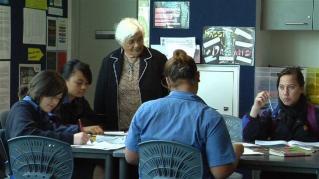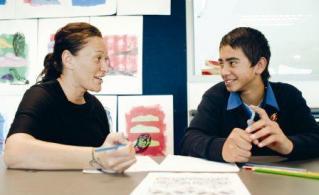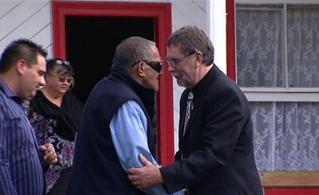Transcript
Narration
At Hiruharama School, the process of learning is expressly communicated to all the students.
Keriana Grant – Teacher, Hiruharama School
We’re extremely transparent in everything that we do in our class. We have a tasks board up in our class, and everything is up there, right from what the programme is going to be, what tasks the children are going to be. Everything that contains or relates to their learning, right through to learning intentions. And the children have input into that. We all know exactly what’s happening in our room.
Bill Hughes – Principal, Hiruharama School
They’ve asked the children, is that alright with them? – “Kei te pai?”. You know, “Do you mind your learning being shared up on the wall with everyone else?”. And what I’ve noticed is that they… not only are they interested in what their own learning is and where it’s going, but they’re also very encouraging with other children.
Maria Stevenson – Student, Hiruharama School
Each group knows who they are with and who they are working with, so they can ask them questions for the activities. If the teacher’s not available, then we can go to the higher group to ask for help.
Michael McClutchie – Student, Hiruharama School
I think the wall is very important, so we know where we’re learning and... so we can set goals for the future to move up in our levels.
Narration
Digital portfolios created and maintained by the students are a vehicle for communicating learning to whānau.
Keriana Grant
This is the second year that we’ve implemented the digital portfolio approach to children actually taking ownership of their learning, and presenting their learning – where they have come from, where they are at, at the moment in time, and where they’re heading – to their own whānau.
Raniera Reuben – Student, Hiruharama School
Show them what I can do, and what I learn, how good I am at maths, spelling and that. So they think that I don’t just come to school to eat my lunch.
Narration
Hiruharama’s pānui pukapuka, pj’s and purini night is one example of schools and whānau working together to establish what works best in building better relationships, while still focusing on learning.
Bill Hughes
This year we did something a little bit different – we actually got the children to run it. That was from an idea by one of the advisers in the Gisborne team. And that was just so powerful.
Maria Stevenson – Student, Hiruharama School
We presented all our learning intentions and our task board. And then all the classes and the parents moved over to the staffroom to have some pudding.
Paula Walker – Parent, Hiruharama School
For me, it’s a link into my daughter’s education because I can see the strategies that the teachers are using to teach them. So that when she comes home I know where she’s at.
Wi O Te Rangi Morice – Parent, Hiruharama School
We’re learning as well. So yeah, the different strategies. And we’ll go home and do them on the kids.
Merekatene Tuhura – Parent, Hiruharama School
It keeps us involved. So it’s not like we send our kids to school just to learn and then we don’t know what they’re doing at school. And it involves us. And then it’s for our children to tell us. It’s not for the teachers to tell us what our kids are doing – it’s for our kids to tell us what they’re doing.
Keriana Grant – Teacher, Hiruharama School
Because the children were the facilitators of the evening, they were the ones standing up in front of the whānau. We just had whānau coming from everywhere. And it was just so neat, it really just brought tears to your eyes. By the end of the evening we were just jam-packed – there weren’t enough seats.
Bill Hughes
It’s having huge spin-offs. And we can see it working in a whānau, from the oldest child to the youngest child. That there is some movement there, in attitudes, and also in skills and knowledge.
Mason Durie – Deputy Vice Chancellor Māori, Massey University
All children belong to whānau one way or another. And... it’s easy, I think, for children, if their world is not a fragmented one. And having the school and the whānau see eye-to-eye on issues, and to be seen to be working collaboratively towards a joint end – I think it’s hugely important to a successful learning outcome. There’s also quite a lot of evidence to show that when schools are able to engage effectively with the community, including families and whānau, then there are better learning outcomes.





